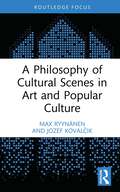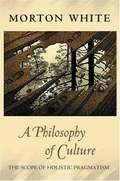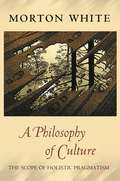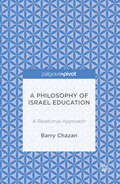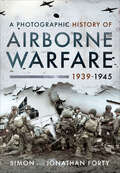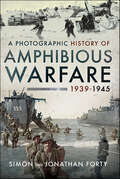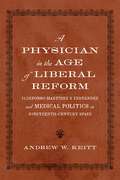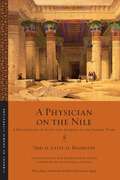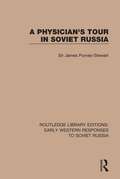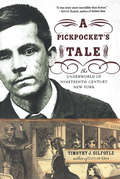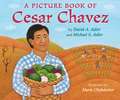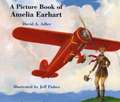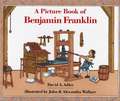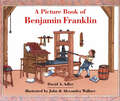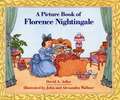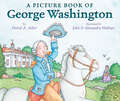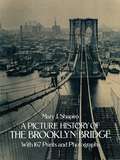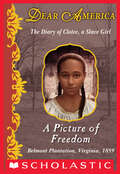- Table View
- List View
A Philosophy of Cultural Scenes in Art and Popular Culture (Routledge Focus on Art History and Visual Studies)
by Max Ryynänen Jozef KovalčikThis book seeks to understand culture through the lens of scenes, analyzing them aesthetically and culturally as well as understanding them through the frameworks of gender, social networks, and artworlds. It is common to talk about the cultural and intellectual scenes of early twentieth-century Vienna, the visual art scene of postwar New York, and the music and fashion scene of the swinging London. We often think about artists and works of art as essentially belonging to a certain scene. Scenes might offer a new approach to study what is possible, what is a tradition, and/or to discuss what are the relevant units of contemporary culture for research. The book posits that scenes explain a lot about how the artworld and the cultural field function. Vivienne Westwood, Rene Magritte, Roman Jakobson, Arthur C. Danto, Susan Sontag, James Baldwin, and Didier Eribon are among the figures included in the book, which examines scenes in cities such as Moscow, Bombay, New York, London, Paris, Brussels, Helsinki, and Bratislava. The book will be of interest to scholars working in art history, cultural studies, philosophy, film, literature, and urban studies.
A Philosophy of Culture: The Scope of Holistic Pragmatism
by Morton WhiteIn this book, one of America's leading philosophers offers a sweeping reconsideration of the philosophy of culture in the twentieth century. Morton White argues that the discipline is much more important than is often recognized, and that his version of holistic pragmatism can accommodate its breadth. Going beyond Quine's dictum that philosophy of science is philosophy enough, White suggests that it should contain the word "culture" in place of "science." He defends the holistic view that scientific belief is tested by experience but that such testing is rightly applied to systems or conjunctions of beliefs, not isolated beliefs. He adds, however, that we test ethical systems by appealing to feelings of moral obligation as well as to sensory experiences. In the course of his lucidly written analysis, White treats central issues in the philosophy of science, of religion, of art, of history, of law, of politics, and of morality. While doing so he examines the views of Quine, Tarski, Goodman, and Rawls, and shows how they are related to the approaches of Peirce, James, Duhem, Russell, Dewey, Carnap, and the later Wittgenstein. He also discusses the ideas of the legal philosophers Holmes and Hart from a holistic standpoint. White demonstrates how his version of pragmatism bridges the traditional gulf between analytic and synthetic truth as well as that between moral and scientific belief. Indeed, the high point of the book is a brilliant presentation of his view of ethics, based on the idea that our scientific theories face the tribunal of observation whereas our ethical views face the joint tribunal of observation and moral feeling. Scholars and students of the history of ideas and of philosophy will welcome A Philosophy of Culture as the highly finished product of more than sixty years of philosophical reflection by an important thinker.
A Philosophy of Culture: The Scope of Holistic Pragmatism
by Morton WhiteIn this book, one of America's leading philosophers offers a sweeping reconsideration of the philosophy of culture in the twentieth century. Morton White argues that the discipline is much more important than is often recognized, and that his version of holistic pragmatism can accommodate its breadth. Going beyond Quine's dictum that philosophy of science is philosophy enough, White suggests that it should contain the word "culture" in place of "science." He defends the holistic view that scientific belief is tested by experience but that such testing is rightly applied to systems or conjunctions of beliefs, not isolated beliefs. He adds, however, that we test ethical systems by appealing to feelings of moral obligation as well as to sensory experiences. In the course of his lucidly written analysis, White treats central issues in the philosophy of science, of religion, of art, of history, of law, of politics, and of morality. While doing so he examines the views of Quine, Tarski, Goodman, and Rawls, and shows how they are related to the approaches of Peirce, James, Duhem, Russell, Dewey, Carnap, and the later Wittgenstein. He also discusses the ideas of the legal philosophers Holmes and Hart from a holistic standpoint. White demonstrates how his version of pragmatism bridges the traditional gulf between analytic and synthetic truth as well as that between moral and scientific belief. Indeed, the high point of the book is a brilliant presentation of his view of ethics, based on the idea that our scientific theories face the tribunal of observation whereas our ethical views face the joint tribunal of observation and moral feeling. Scholars and students of the history of ideas and of philosophy will welcome A Philosophy of Culture as the highly finished product of more than sixty years of philosophical reflection by an important thinker.
A Philosophy of Israel Education: A Relational Approach
by Barry ChazanThis book develops a new philosophy of Israel education. Person-centered Israel education is concerned with developing in individual learners the ability to understand and make rational, emotional, and ethical decisions about Israel, and about the challenges Israel regularly faces, whether they be existential, spiritual, democratic, humanitarian, national, etc. Chazan begins by laying out the terms of the conversation then examines the six-pronged theory of person-centered Israel education to outline the aims, content, pedagogy, and educators needed to implement this program. Finally, the author meditates on what a transformation from ethnic to ethical education might look like in this context and others. This book is Open Access under a CC-BY license. "
A Photographic History of Airborne Warfare, 1939–1945
by Simon Forty Jonathan FortyOn 10 May 1940 German Fallschirmjäger stormed the Dutch fort of Eben-Emael, south of Maastricht. The brilliantly executed operation was the first signal success by airborne troops in the Second World War and it made the military world sit up and take notice. Improved parachutes and the creation of gliders that could carry troops meant that assault forces could be dropped or landed behind enemy lines. This was a significant new tactic which had a dramatic impact on several of the key campaigns, and it is the subject of Simon and Jonathan Forty’s in-depth, highly illustrated history. They tell the story of the development of airborne forces, how they were trained and equipped, and how they were landed and put into action in every theatre of the global conflict. The results were mixed. German airborne forces were victorious on Crete, but the cost was so great that Hitler vowed never to use them in the same way again. The Allies saw things differently. After Crete they built up elite units who would play important roles in later battles – in Normandy, for example, where the British 6th Airborne Division took vital bridges prior to the D-Day landings. These are just two examples of the many similar operations on the Western and Eastern Fronts and in the Pacific which are covered in this wide-ranging book. It offers the reader a fascinating insight into airborne warfare over seventy years ago.
A Photographic History of Amphibious Warfare 1939–1945
by Simon Forty Jonathan Forty"...contains a plethora of after-action reports, diagrams and text which makes the work a thorough and engaging study of amphibious landings during the war." —WWII History MagazineAmphibious operations have always been an important element of warfare, but they reached their climax during the Second World War when they were carried out on a large scale in every theater of the conflict. That is why this wide-ranging, highly illustrated history of amphibious warfare 1939–1945 by Simon and Jonathan Forty is of such value. Their book gives graphic accounts of the main amphibious assaults launched by the major combatants, in particular the British, American, German and Japanese – not just large-scale landings like those in North Africa, Normandy, the Philippines and Okinawa, but also raids such as Dieppe and St Nazaire and evacuations like Dunkirk and Kerch. The rapid development of amphibious tactics and equipment is an essential element of the story, as are the vital roles played by the navies, air forces, armies and special forces in each complex combined operation. There is also a section on amphibious operations that were planned but didn’t happen, such as the German invasion of Britain and the Italian and German operation against Malta.
A Physician in the Age of Liberal Reform: Ildefonso Martínez y Fernández and Medical Politics in Nineteenth-Century Spain (New Hispanisms: Cultural and Literary Studies)
by Andrew W. KeittSpanish physicians constituted a crucial political force in the nineteenth century during the tumultuous process of nation-building that followed the War of Independence against the Napoleonic invasion of the Iberian Peninsula. Many participated in the Cortes of Cádiz, which drafted Spain’s first constitution in 1812 and went on to prove highly influential in the public sphere and legislature during the liberal revolution that undertook the establishment of a new, and precarious, political order. Andrew W. Keitt’s A Physician in the Age of Liberal Reform excavates the life and work of one such doctor, Ildefonso Martínez y Fernández, whose brief career coincided with the consolidation of the liberal revolution and the drive to improve and professionalize Spanish medicine. Born in 1821, Martínez was a polymath and activist whose prolific literary and scholarly output made him a fixture in the political and intellectual ferment of midcentury Spain until his untimely death in 1855 during a devastating outbreak of cholera. He produced a significant body of intellectual research, made key contributions to the profession, and cultivated a deep engagement with the political struggles of the period. His impassioned endeavors, as chronicled by Keitt, highlight the efforts of Spanish physicians to mobilize medical science toward forging a new political culture for liberal Spain.
A Physician on the Nile: A Description of Egypt and Journal of the Famine Years (Library of Arabic Literature)
by ʿAbd al-Laṭīf al-BaghdādīFlora, fauna, and famine in thirteenth-century Egypt A Physician on the Nile begins as a description of everyday life in Egypt at the turn of the seventh/thirteenth century, before becoming a harrowing account of famine and pestilence. Written by the polymath and physician ʿAbd al-Laṭīf al-Baghdādī, and intended for the Abbasid caliph al-Nāṣir, the first part of the book offers detailed descriptions of Egypt’s geography, plants, animals, and local cuisine, including a recipe for a giant picnic pie made with three entire roast lambs and dozens of chickens. ʿAbd al-Laṭīf’s text is also a pioneering work of ancient Egyptology, with detailed observations of Pharaonic monuments, sculptures, and mummies. An early and ardent champion of archaeological conservation, ʿAbd al-Laṭīf condemns the vandalism wrought by tomb-robbers and notes with distaste that Egyptian grocers price their goods with labels written on recycled mummy-wrappings. The book’s second half relates his horrific eyewitness account of the great famine that afflicted Egypt in the years 597–598/1200–1202. ʿAbd al-Laṭīf was a keen observer of humanity, and he offers vivid first-hand depictions of starvation, cannibalism, and a society in moral free-fall. A Physician on the Nile contains great diversity in a small compass, distinguished by the acute, humane, and ever-curious mind of its author. It is rare to be able to hear the voice of such a man responding so directly to novelty, beauty, and tragedy.An English-only edition.
A Physician's Tour in Soviet Russia (RLE: Early Western Responses to Soviet Russia #14)
by James Purves-StewartOriginally published in 1933, this volume was written by a practicing physician who visited Russia during the summer of 1932. Although the book makes no claim to offer anything more than a transient view of the constantly changing condition of Russian life, the picture it gives to those who knew Russia before the Great War is unrecognizable. Observed by medical eyes, this volume offers a distinctive point of view, different from the other journalists writing at the time, but the language is still accessible for the non-medic.
A Pickpocket's Tale: The Underworld of Nineteenth-Century New York
by Timothy J. Gilfoyle"A remarkable tale."--Chicago Tribune In George Appo's world, child pickpockets swarmed the crowded streets, addicts drifted in furtive opium dens, and expert swindlers worked the lucrative green-goods game. On a good night Appo made as much as a skilled laborer made in a year. Bad nights left him with more than a dozen scars and over a decade in prisons from the Tombs and Sing Sing to the Matteawan State Hospital for the Criminally Insane, where he reunited with another inmate, his father. The child of Irish and Chinese immigrants, Appo grew up in the notorious Five Points and Chinatown neighborhoods. He rose as an exemplar of the "good fellow," a criminal who relied on wile, who followed a code of loyalty even in his world of deception. Here is the underworld of the New York that gave us Edith Wharton, Boss Tweed, Central Park, and the Brooklyn Bridge.
A Picture Book Of Cesar Chavez
by David A. Adler Michael S. Adler Marie OlofsdotterCesar Chavez dedicated his life to helping American farmworkers. As a child growing up in California during the Great Depression, he picked produce with his family. Cesar saw firsthand how unfairly workers were treated. As an adult, he organized farmworkers into unions and argued for better pay and fair working conditions. He was jailed for his efforts, but he never stopped urging people to stand up for their rights. Young readers will be inspired by the fascinating life story of this champion of social justice.
A Picture Book Of Jesse Owens
by David A. AdlerA simple biography of the noted black track star who competed in the 1936 Berlin Olympics.
A Picture Book of Amelia Earhart
by David A. AdlerDiscusses the life of the pilot who was the first woman to cross the Atlantic by herself in a plane.
A Picture Book of Anne Frank
by David A. AdlerTraces the life of the young Jewish girl whose diary chronicles the years she and her family hid from the Nazis in an Amsterdam attic.
A Picture Book of Benjamin Franklin
by David A. AdlerSurveys the life of Benjamin Franklin, highlighting his work as an inventor and statesman.
A Picture Book of Benjamin Franklin (Picture Book Biography)
by David A. AdlerWriter, printer, scientist, inventor, statesman, and youngest son in a family of seventeen children, Benjamin Franklin is considered one of our greatest Americans.Supported by colorful illustrations, Adler's biography brings to life one of America's founding fathers, Benjamin Franklin. Adler highlights Franklin's stunning accomplishments and his day-to-day life from his time as a young boy in Boston, Massachusetts through his role as the oldest delegate to the Constitutional Congress at the age of 81.A lifelong book lover and printer, Franklin poularized famous sayings like "haste makes waste" and "early to bed, early to rise, makes a man healthy, wealthy, and wise" in his annual Poor Richard's Almanack. An energetic inventor and public servant, he created the Franklin stove and bifocal glasses and established the first lending library and hospital in America.Young readers looking for insight into one of America's greatest founders, will find inspiration while gaining understanding and appreciation of US colonial history.
A Picture Book of Christopher Columbus (Picture Biography Series)
by David A. AdlerFrom the Book jacket: Born in Genoa, Italy, in 1451, Christopher Columbus dreamed of going to sea. He knew the earth was round, and planned a voyage west into the unknown waters of the Atlantic to reach the Indies. But it wasn't until he was 41 years old that Queen Isabella and King Ferdinand of Spain gave him the funds, the three boats, and the men to make a voyage. Even though Columbus never reached the Indies, he made a more important discovery. On October 12, 1492, he landed on an island southeast of Florida. Since he thought he had reached the Indies, he named the natives Indians. Columbus made three more voyages and is credited with discovering the New World.
A Picture Book of Florence Nightingale
by David A. AdlerFlorence Nightingale was the daughter of a rich family from England, but she felt that her life could be so much more. She decided to become a nurse and because of her we have clean hospitals and good nursing care. This biography for younger readers tells the life of Florence and her incredible work in the United Kingdom for better hospital care.
A Picture Book of George Washington (Picture Book Biography)
by David A. AdlerThe life and legacy of our nation's first president, also known as commander of the Continental Army, husband to Martha, and an avid farmer and equestrian. Over two hundred years after his death, George Washington remains one of the most studied figures in American history. This clear and concise picture book biography covers the important facts and historical background, complemented by charming illustrations. The text details Washington's early life as well as the Revolutionary War and his impressive career as leader of the newly formed United States. Young readers will love learning more about the man who was "first in war, first in peace, and first in the hearts of his countrymen." Back matter features a timeline. For almost thirty years, David Adler&’s Picture Book Biography series has profiled famous people who changed the world. Colorful, kid-friendly illustrations combine with Adler&’s &“expert mixtures of facts and personality&” (Booklist) to introduce young readers to history through compelling biographies of presidents, heroes, inventors, explorers, and adventurers. These books are ideal for first and second graders interested in history, or who need reliable sources for school book reports.
A Picture Book of Harriet Tubman (Picture Book Biography)
by David A. AdlerFor young readers, an illustrated introduction to an American hero—the legendary Harriet Tubman. From her rebellious childhood to her daring escape from slavery, Harriet Tubman was a confident, fearless woman. After heading North in search of freedom, she risked her life, again and again, to lead others out of slavery, devoting herself to guiding almost three hundred individuals along the network of safe havens known as the Underground Railroad. Called "General Tubman" for her strength and bravery, Harriet went on to work as a nurse and spy for the northern army in the Civil War. She fought tirelessly for women's right to vote, and help to open a home for poor and elderly African Americans, to which she eventually retired. Celebrated nonfiction author David A. Adler tells about Harriet Tubman's life and character, showing why she was so admired and beloved. A timeline of important dates is included. For almost thirty years, David Adler&’s Picture Book Biography series has profiled famous people who changed the world. Colorful, kid-friendly illustrations combine with Adler&’s "expert mixtures of facts and personality" (Booklist) to introduce young readers to history through compelling biographies of presidents, heroes, inventors, explorers, and adventurers. These books are ideal for first and second graders interested in history or who need reliable sources for school book reports.
A Picture Book of Harry Houdini (Picture Book Biography)
by David A. Adler Michael S. AdlerHarry Houdini astounded audiences around the globe with his death-defying acts and illusions. With his wife, Bess, often by his side, he freed himself from ropes, handcuffs, straitjackets, and prison cells. Once he even made a ten-thousand-pound elephant vanish into thin air! Yet Harry's life was not always so glamorous. When he was a boy, he shined shoes and did odd jobs to help make ends meet. But a career in magic was always in the cards for Harry. Readers will be mesmerized by this captivating biography of one of the most celebrated escape artists and magicians in history.
A Picture Book of Sacagawea
by David A. AdlerA biography of the Shoshone woman who joined the Lewis and Clark Expedition.
A Picture Book of Samuel Adams
by David A. Adler Ronald Himler Michael S. AdlerThis is the story of Samuel Adams, American Patriot and a founding father of the new American nation. He wrote and spoke out about the unfair British taxes imposed upon the colonists and helped organize the Stamp Act. He instigated the Boston Tea Party - an act of rebellion by the Sons of Liberty that would lead directly to the Revolutionary War. He was a delegate at the First and Second Continental Congresses, and was one of the signers of the Declaration of Independence in 1776. Adams continued to lead the struggle for liberty until his death. In this book, the Adlers offer a compelling hero for young readers - a man passionate about freedom, and determined to make a difference.
A Picture History of the Brooklyn Bridge
by Mary J. ShapiroProfusely illustrated account of the greatest engineering achievement of the 19th century. Rare contemporary photos and engravings, accompanied by extensive, detailed captions, recall construction, human drama, politics, much more. 167 black-and-white illustrations.
A Picture of Freedom: A Picture Of Freedom (Dear America)
by Patricia C. MckissackCoretta Scott King Award winner and Newbery Honor author Patricia McKissack's inspiring A PICTURE OF FREEDOM is now back in print with a gorgeous new cover! It's 1859 and Clotee, a twelve-year-old slave, has the most wonderful, terrible secret. She knows that if she shares it with the wrong person, she will face unimaginable consequences. What is her secret? While doing her job of fanning her master's son during his daily lessons, Clotee has taught herself to read and write. However, she soon learns that the tutor, Ely Harms, has a secret of his own. In a time when literacy is one of the most valuable skills to have, Clotee is determined to use her secret to save herself, and her family.
